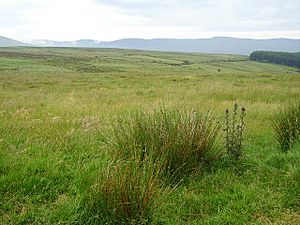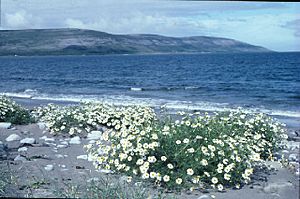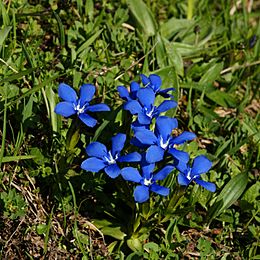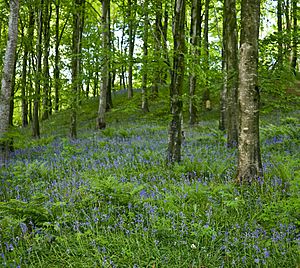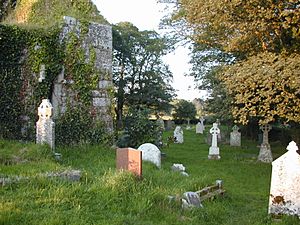Flora of Ireland facts for kids
Ireland is an island in Europe, known for its beautiful green landscapes. It's part of a larger plant region called the Circumboreal Region. This article will tell you all about the amazing plants that grow here!
Contents
What Plants Live in Ireland?
Ireland has a good variety of plants, but not as many as some other European countries. This is because it's a smaller island and doesn't have a huge range of different land types. Also, its history after the Ice Age played a big role.
There are 3,815 different kinds of plants listed for Ireland. These include:
- Flowering plants: 2,196 species (the most common type!)
- Mosses: 556 species
- Red algae: 339 species
- Liverworts: 229 species
- Charophytes: 244 species
- Ferns: 79 species
- Pines (like conifers): 12 species
- Clubmosses: 9 species
- Hornworts: 3 species
- Green algae: 148 species
Ireland also has 2,512 different types of fungus. These include:
- Sac fungi: 1,115 species
- Club fungi (like mushrooms): 1,228 species
- Slime molds: 112 species
- Water molds: 40 species
- Pin or sugar molds: 11 species
- Chytrids: 4 species
- Cellular slime molds: 1 species
- Microsporidia: 1 species
How Ireland's Plants Returned After the Ice Age
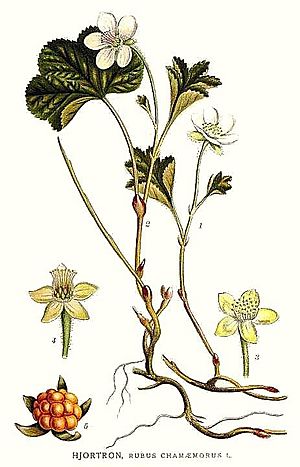
About 13,000 years ago, huge sheets of ice covered most of Ireland. This was the end of the last Ice Age. As the climate got warmer, the ice melted. Most of Ireland's plants and animals slowly came back.
About 10,000 years ago, the sea level was much lower. This meant there was a land bridge connecting Wales to the east coast of Ireland. Plants and animals could cross this bridge easily. But as the world kept warming, the sea level rose. Around 7,500 years ago, the land bridge was covered by water.
Humans arrived in Ireland about 10,000 years ago. Over time, especially in the last two centuries, farming changed the landscape a lot. New plant species were also brought in, sometimes on purpose and sometimes by accident.
Where Do Ireland's Plants Live? (Habitats)
Plants live in different "homes" or habitats. Most of Ireland's land is made up of two main types: grasslands and bogs.
Grassland Habitats
Grasslands are areas covered mostly by grasses.
Lowland Meadows and Pastures
These are fields where animals often graze. You'll find grasses like perennial ryegrass and Yorkshire fog. Many pretty flowers grow here too, such as ragged robin, lesser knapweed, meadow buttercup, and dandelion.
Upland Pastures
These are higher areas, often kept open by grazing animals. Common plants include moor matgrass, cross-leaved heath, bilberry, and bog asphodel.
Bog Habitats
Bogs are very wet, spongy areas where special plants grow.
Why Bogs Are Important
Ireland has a huge amount of actively growing bogs and fens. This is much more than many other European countries. These bogs are very important for nature conservation in Europe.
How Bogs Are Formed
Bogs formed in Ireland because of two main reasons:
- Lots of rain: The west of Ireland gets rain almost every day.
- Poor drainage: The land doesn't let water drain away easily.
Bogs started forming about 10,000 years ago, after the last Ice Age. Lakes in the middle of Ireland slowly filled with fen plants. These plants created a layer of peat. This peat cut off the surface plants from the mineral-rich water below. Then, special bog mosses and plants that don't need many nutrients started to grow. These plants are like sponges, soaking up rainwater and creating the wet, boggy conditions.
Plants of the Bogs
Many unique plants thrive in bogs. Some common ones include common heather, cross-leaved heath, bogbean, cottongrass, bog-rosemary, common cranberry, bog myrtle, and different types of sundew (which are carnivorous plants!). You might also see royal fern and various bladderworts.
When parts of bogs are cut away, they can become wet woodlands. Here, you'll find trees like downy birch and black alder.
Open Water Habitats

These are places with water, like rivers, canals, lakes, and ponds. Ireland also has unique lakes called turloughs that appear and disappear. Common plants in wet places include common reed, marsh marigold, yellow water lily, bulrush, and watermint.
Sea Shore Habitats
The coast of Ireland has many different types of habitats. These include muddy shores, rocky shores, sandy beaches, and sea cliffs. On sand dunes, you might find marram grass, sea holly, and colorful pyramidal orchids. In salty marshes, plants like Salicornia europaea and sea purslane grow.
Karst Habitats
Karst areas are places with lots of exposed limestone rock.
The Burren
The Burren in County Clare is a very special place for plants. Even though it's a small area (less than 0.5% of Ireland), over 70% of Ireland's native plant species grow there! It has a mix of plants usually found in cold, northern mountains (like Arctic–alpine species) and plants from warmer, southern areas (like Mediterranean species). This makes it very unique. The Burren has many different kinds of plants because of its special rocky soil and how it's farmed. You can find 22 of Ireland's 27 native orchid species here.
Woodland Habitats
Woodlands are areas with many trees. In Irish woodlands, you'll find plants like wood sorrel, bluebell, ramsons, honeysuckle, and holly. Some woodlands, especially in the uplands, are called "western oakwoods." They are like temperate rainforests because they get a lot of rain.
Artificial Habitats
These are places that humans have changed, like quarries, roadsides, railway lines, and even old walls or rubbish tips. Plants that can grow in these disturbed areas include common ragwort, pineapple weed, nettle, common daisy, and rosebay willowherb. Cultivated areas like farms and gardens also count as artificial habitats.
Protecting Ireland's Plants (Conservation)
It's very important to protect Ireland's plants. Some things that threaten them include:
- Changes in farming
- Building new houses and golf courses
- Draining wet areas
- Mowing roadside verges too often
- New species of plants that are not native and can take over.
Many groups work to protect Ireland's plants and their habitats. These include the National Parks and Wildlife Service, the Northern Ireland Environment Agency, and the Environmental Protection Agency. Organizations like the Irish Peatland Conservation Council and the Native Woodland Trust also help. The National Botanic Gardens has a special program to protect threatened plant species.
Plant Collections (Herbaria)
Herbaria are like libraries for dried plant specimens. They are important for studying and understanding plants. Major herbaria in Ireland are kept at the National Botanic Gardens and the Ulster Museum.



